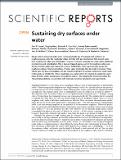| dc.contributor.author | Jones, Paul R. | |
| dc.contributor.author | Hao, Xiuqing | |
| dc.contributor.author | Cruz-Chu, Eduardo R. | |
| dc.contributor.author | Rykaczewski, Konrad | |
| dc.contributor.author | Nandy, Krishanu | |
| dc.contributor.author | Schutzius, Thomas M. | |
| dc.contributor.author | Varanasi, Kripa K. | |
| dc.contributor.author | Megaridis, Constantine M. | |
| dc.contributor.author | Walther, Jens H. | |
| dc.contributor.author | Koumoutsakos, Petros | |
| dc.contributor.author | Espinosa, Horacio D. | |
| dc.contributor.author | Patankar, Neelesh A. | |
| dc.date.accessioned | 2015-12-28T13:26:13Z | |
| dc.date.available | 2015-12-28T13:26:13Z | |
| dc.date.issued | 2015-08 | |
| dc.date.submitted | 2015-02 | |
| dc.identifier.issn | 2045-2322 | |
| dc.identifier.uri | http://hdl.handle.net/1721.1/100527 | |
| dc.description.abstract | Rough surfaces immersed under water remain practically dry if the liquid-solid contact is on roughness peaks, while the roughness valleys are filled with gas. Mechanisms that prevent water from invading the valleys are well studied. However, to remain practically dry under water, additional mechanisms need consideration. This is because trapped gas (e.g. air) in the roughness valleys can dissolve into the water pool, leading to invasion. Additionally, water vapor can also occupy the roughness valleys of immersed surfaces. If water vapor condenses, that too leads to invasion. These effects have not been investigated, and are critically important to maintain surfaces dry under water. In this work, we identify the critical roughness scale, below which it is possible to sustain the vapor phase of water and/or trapped gases in roughness valleys – thus keeping the immersed surface dry. Theoretical predictions are consistent with molecular dynamics simulations and experiments. | en_US |
| dc.language.iso | en_US | |
| dc.publisher | Nature Publishing Group | en_US |
| dc.relation.isversionof | http://dx.doi.org/10.1038/srep12311 | en_US |
| dc.rights | Creative Commons Attribution | en_US |
| dc.rights.uri | http://creativecommons.org/licenses/by/4.0/ | en_US |
| dc.source | Nature Publishing Group | en_US |
| dc.title | Sustaining dry surfaces under water | en_US |
| dc.type | Article | en_US |
| dc.identifier.citation | Jones, Paul R., Xiuqing Hao, Eduardo R. Cruz-Chu, Konrad Rykaczewski, Krishanu Nandy, Thomas M. Schutzius, Kripa K. Varanasi, et al. “Sustaining Dry Surfaces Under Water.” Scientific Reports 5 (August 18, 2015): 12311. | en_US |
| dc.contributor.department | Massachusetts Institute of Technology. Department of Mechanical Engineering | en_US |
| dc.contributor.mitauthor | Varanasi, Kripa K. | en_US |
| dc.relation.journal | Scientific Reports | en_US |
| dc.eprint.version | Final published version | en_US |
| dc.type.uri | http://purl.org/eprint/type/JournalArticle | en_US |
| eprint.status | http://purl.org/eprint/status/PeerReviewed | en_US |
| dspace.orderedauthors | Jones, Paul R.; Hao, Xiuqing; Cruz-Chu, Eduardo R.; Rykaczewski, Konrad; Nandy, Krishanu; Schutzius, Thomas M.; Varanasi, Kripa K.; Megaridis, Constantine M.; Walther, Jens H.; Koumoutsakos, Petros; Espinosa, Horacio D.; Patankar, Neelesh A. | en_US |
| dc.identifier.orcid | https://orcid.org/0000-0002-6846-152X | |
| mit.license | PUBLISHER_POLICY | en_US |
| mit.metadata.status | Complete | |
